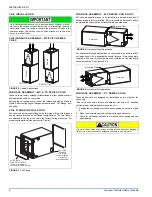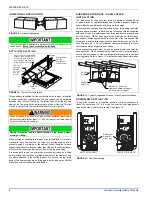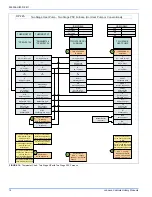
505309-UIM-D-0511
2
Johnson Controls Unitary Products
These high efficiency, compact units employ induced combustion, reli-
able hot surface ignition and high heat transfer aluminized tubular heat
exchangers. The units are factory shipped for installation in upflow or
horizontal applications and may be converted for downflow applica-
tions.
These furnaces are designed for residential installation in a basement,
closet, alcove, attic, recreation room or garage and are also ideal for
commercial applications. All units are factory assembled, wired and
tested to assure safe dependable and economical installation and oper-
ation.
These units are Category IV listed and may not be common vented with
another gas appliance as allowed by the National Fuel Gas Code.
SECTION I: SAFETY
This is a safety alert symbol. When you see this symbol on
labels or in manuals, be alert to the potential for personal
injury.
Understand and pay particular attention to the signal words
DANGER
,
WARNING
, or
CAUTION
.
DANGER
indicates an
imminently
hazardous situation, which, if not
avoided,
will result in death or serious injury
.
WARNING
indicates a
potentially
hazardous situation, which, if not
avoided,
could result in death or serious injury
.
CAUTION
indicates a potentially hazardous situation, which, if not
avoided
may result in minor or moderate injury.
It is also used to
alert against unsafe practices and hazards involving only property dam-
age.
SPECIFIC SAFETY RULES AND PRECAUTIONS
1. Only Natural gas or Propane (LP) gas are approved for use with this
furnace.
2.
Install this furnace only in a location and position as specified in
these instructions.
3.
A gas-fired furnace for installation in a residential garage must be
installed as specified in these instructions.
4.
Provide adequate combustion and ventilation air to the furnace
space as specified in these instructions.
5.
Combustion products must be discharged outdoors. Connect this
furnace to an approved vent system only, as specified in SECTION
VIII, "COMBUSTION AIR and VENT SYSTEM" of these instruc-
tions.
6.
Test for gas leaks as specified in these instructions.
7.
Always install the furnace to operate within the furnace’s intended
temperature rise range. Only connect the furnace to a duct system
which has an external static pressure within the allowable range, as
specified on the furnace rating plate.
8.
When a furnace is installed so that supply ducts carry air circulated
by the furnace to areas outside the space containing the furnace,
the return air shall also be handled by duct(s) sealed to the furnace
casing and terminating outside the space containing the furnace.
9.
It is permitted to use the furnace for heating of buildings or struc-
tures under construction where the application and use must com-
ply with all manufacturer’s installation instructions including:
• Proper vent installation;
• Furnace operating under thermostatic control;
• Return air duct sealed to the furnace;
• Air filters in place;
• Set furnace input rate and temperature rise per rating plate mark-
ing;
• Means for providing outdoor air required for combustion;
• Return air temperature maintained between 55ºF (13ºC) and
80ºF (27ºC);
• The
air filter must be replaced
upon substantial completion of
the construction process;
• Clean furnace, duct work and components upon substantial com-
pletion of the construction process, and verify furnace-operating
conditions including ignition, input rate, temperature rise and
venting, according to the manufacturer’s instructions.
10. When installed in a non-HUD-Approved Modular Home or building
constructed on-site, combustion air shall not be supplied from occu-
pied spaces.
11. The size of the unit should be based on an acceptable heat loss
calculation for the structure. ACCA, Manual J or other approved
methods may be used.
12. When moving or handling this furnace prior to installation, always
leave the doors on the furnace to provide support and to prevent
damage or warping of the cabinet. When lifting the furnace by the
cabinet, support the ends of the furnace rather than lifting by the
cabinet flanges at the return air openings (bottom or sides) or sup-
ply air opening.
13. When lifting the furnace, it is acceptable to use the primary heat
exchanger tubes as a lifting point provided that the tubes are lifted
at the front of the heat exchangers where attached to the vestibule
panel. Do not use the top return bend of the heat exchangers as lift-
ing points as the tubes may shift out of position or their location
brackets/baffles.
SAFETY REQUIREMENTS
• Refer to the unit rating plate for the furnace model number, and
then see the dimensions page of this instruction for return air ple-
num dimensions in Figure 13. The plenum must be installed
according to the instructions.
• Provide clearances from combustible materials as listed under
Clearances to Combustibles.
• Provide clearances for servicing ensuring that service access is
allowed for both the burners and blower.
• These models
ARE NOT
CSA listed or approved for installation
into a
HUD Approved Modular Home
or a
Manufactured
(Mobile) Home
.
Improper installation may create a condition where the operation of
the product could cause personal injury or property damage.
Improper installation, adjustment, alteration, service or maintenance
can cause injury or property damage. Failure to carefully read and
follow all instructions in this manual can result in furnace mal-
function, death, personal injury and/or property damage. Only a
qualified contractor, installer or service agency should install this
product.
FIRE OR EXPLOSION HAZARD
Failure to follow the safety warnings exactly could result in serious
injury, death or property damage.
Never test for gas leaks with an open flame. Use a commercially
available soap solution made specifically for detection of leaks to
check all connections. A fire or explosion may result causing property
damage, personal injury or loss of life.
During installation, doors should remain on the furnace when
moving or lifting.
This product must be installed in strict compliance with the installation
instructions and any applicable local, state, and national codes
including, but not limited to building, electrical, and mechanical codes.



































